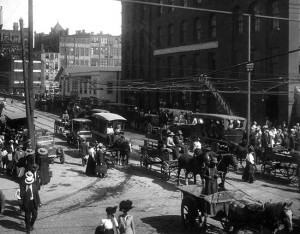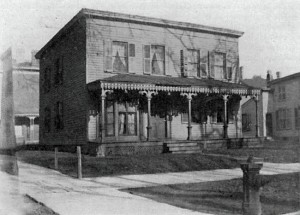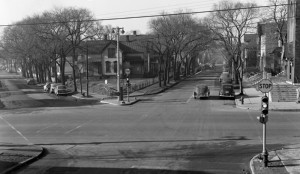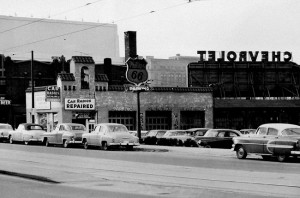This mystery photo is from 1912 and shows a busy downtown street corner. The nearest building on the right is the Hartman’s Warehouse and in the background can be seen the Hansen Glove and Mitten Factory. There are lots of wagons, cabs, buses and cars – obviously this was a big transportation center. Where was the picture and what was reason for all the people?
On this day back in 1926, Prohibition was in in full swing. People who wanted their favorite beverage had to find some place to slake their thirst. Luckily Milwaukee had plenty of illegal underground bars that catered to their needs. Karl Raatzch, who founded the Milwaukee restaurant which still bears his name, ran an underground beer hall just south of Steinmeyer’s store on the corner of 3rd and Highland.
Milwaukee Journal, April 24, 1926
Karl Raatzsch Saloon Raided
Federal Agents Uncover Large Supply of Beer in Place
Karl A. Raatzsch, proprieter of a bar at 310 Third St., which was known to thousands of Milwaukeeans before prohibition and has retained its fame since, was arrested late Friday following a raid on the place by federal prohibition agents. In view of the fact that no fear was entertained that he would not appear when wanted, Harry L. Kellogg, United States commissioner, allowed him his liberty without bail.
Before prohibition the place was known as “the wein stube” because it was one of the few saloons in Milwaukee that catered to wine drinkers, and it was probably the only one that catered to wine drinkers who could afford only the inexpensive wines. A huge glass of wine was sold for a nickel, and it was a common saying that the cheapest way to be relieved temporarily of worry and care was to go to the wein stube and drink a glass or two of wine.
Revived by Raatzsch
The place dropped into obscurity in the early days of prohibition, but its fame began to revive when Raatzsch took hold of it a few years ago. It has come to be one of the most widely known places in the city, and it reputation rested solely on its meals and its beer. Beer was the only alcoholic beverage that the prohibition agents found.
Agents had made purchases of beer in the place previously, and late Friday another purchase was made. The raid followed.
Beer on Tap
Two half-barrels of beer were on tap, the beer flowing through the spigots as before prohibition. The tapped barrels were in the cellar, as was the rest of the contraband seized.
There were 14 other half-barrels all ready for tapping. Each held 15 1/2 gallons. Twenty 15-gallon crocks and two 25-gallon ones held beer in the process of fermentation. Two 15-gallon copper wash boilers stood on two gas plates, with beer “cooking” in them.
There were also two 50-gallon barrels of malt syrup, six barrels of near-beer and eight gallons of brewers’ yeast. this is the first time that brewers’ yeast, which makes much better beer than ordinary yeast has been found in a raid in Milwaukee.
Here is a very old picture of a house that belonged to one of the famous Milwaukeeans whose name is well known enough to have a school named after him. His home was in the heart of downtown and has a historical marker to mark the location. A parking structure is now located on the site of his home. Where was this home located and who was this famous man?
Milwaukee’s German Newspapers; an index of death notices and related items (1844-1930); addenda 1931-1950 / compiled and edited by Gary R. Rebholz.
Milwaukee’s German Newspapers has been set up as a Traveling Data-exhibit and available on a computer at the Salzmann Library since March 1, 2011. This makes the most current data available for researchers searchable by name and browsable by date (Excel Workbook format). There is also a display of some of the notices and articles found in these papers.
The Salzmann Library is located on the grounds of St. Francis de Sales Seminary, in St. Francis (suburban Milwaukee County). It is not the same location as the Milwaukee Archdiocese Archives (Cousins Center). The library staff are not responsible for the data, or for lookups.
This index is the only resource to make these papers accessible to the general public. It is also a comprehensive collection of death notices from all available daily editions published in Milwaukee, 1844-1930. To celebrate the move to the Salzmann library, updates now include entries from 1931-1950 (and later). The data will be updated here every month or so.
What’s the point of all this? The data is available to local researchers.
This newspaper story from 1880 tells the background of several of the important public squares that were in use at the time. Haymarket Square at 5th and McKinley no longer exists after being part of a city redevelopment plan in the late 1960s. It’s site now houses several buildings which are vacant and a power company substation. Rink Square is now where the Wisconsin Center stands at 5th & Kilbourn. Market Square is where the City Hall stands.
Milwaukee Sentinel, September 17, 1880
PROPERTY IN PUBLIC USE
SOME INTERESTING FACTS ABOUT DONATIONS IN EARLY DAYS.
CONDITIONS AND STIPULATIONS UNDER WHICH THE PROPERTY WAS GIVEN – COURTHOUSE, MARKET, HAY MARKET AND OTHER SQUARES.
In the days when Milwaukee was yet a village, and its present prominence undreamt of, it was frequently the case when a plot of land was added to the city, to reserve a portion for public use, the donor at the time making such conditions regarding their future use as he saw fit. Land was not worth $500 a foot on the banks of the Milwaukee River nor had the wildest dreams of the owners conceived it possible that real estate would ever reach that figure. This fact is mentioned to show that the gift of a block then was different pecuniary matter than a like donation today. Many of the original squares have been enlarged by purchase, while others have been used for a purpose other than that for which they were dedicated. This does not interfere with their eligibility for the use to which they are put. The world wags on apace, and, if the original conditions of the benefactions are forgotten, it is because in the flight of time, their usefulness in the sphere for which they were intended has passed away.
In 1835 there was filed in the City Engineer’s office the map of survey of a plot on the West Side of the river, in which was contained one-half block marked “public,” situated on Third street, between Court and Galena. It was specified that this block was given for the erection of a court house, but no other building should be erected thereon. Moreover the court house must be erected within two years from date, or the property was to revert to the original owners. If at any time thereafter, the county should erect a court house elsewhere, or neglected to hold the courts there for three consecutive seasons, it would then revert as aforesaid. If, on the other hand, the reserve was used for this purpose the proprietors of the estate agreed to set apart one lot elsewhere in the town, eligibly situated for a jail, as soon as the county signified a willingness to erect such a structure. The town decided not to erect a courthouse there, and the reservation was left unenclosed and public until 1870, when the authorities purchased the remainder of the block, having in view the erection of a public school building. the project was carried out and the Humboldt public school is the result.
At the same time three other reserves were made for the public, namely: A block on Fifth street, between Poplar(McKinley) and Vliet, known as Haymarket Square, a half-block on Fifth street, between Cedar(Kilbourn) and Tamarack(State), known as the Rink Square, and a half block on Sycamore(Michigan), between Third and Fourth. In the dedication, the donor specified that no obstruction in the way of buildings should be placed thereon except market buildings, on penalty of reversion to former owners. Hay Market Square is the principal live stock market of the city. The Rink reservation will be utilized, together with the remainder of the block, purchased for the purpose, as a site for the Exposition Building.
In 1836, the Court House Square (then half the present size) was dedicated to the common use, by Solomon Juneau, for the purpose of erecting a court house. No other building could be erected thereon, nor should the lot ever be obstructed in any way. Moreover, it was specified that the space should be enclosed by the corporation. The same year a courthouse was built. In 1866 a remainder of the block was purchased by the municipality and the present stone structure erected thereon, and the grounds beautified by a fountain and other embellishments.
Market Square on East Water street, was about the same time given for a public market. This reserve has never been improved much, and stands sadly in need of improvement. A fountain should be placed there, and other innovations brought about, tending to transform a dusty street into a pleasant lounging place. Some such measure introduced would add much to the attractiveness of the Market, and entail good on the neighborhood.
“It is a just remark,” said a gentleman, “that no large public park near the centre of the city is a lack to be regretted, and, although it cannot be well remedied, the regret may be in a measure mitigated by improving the small public squares and making them attractive.




